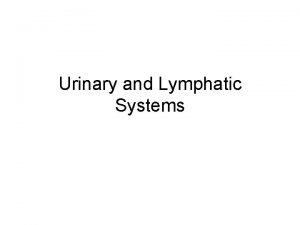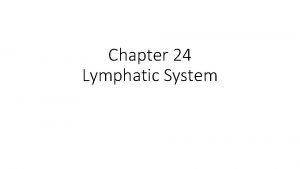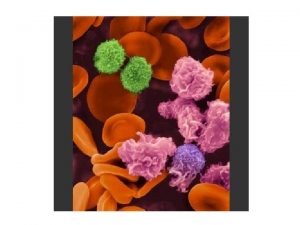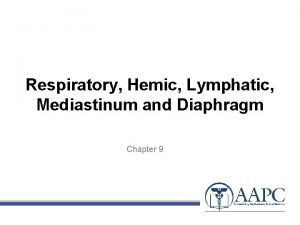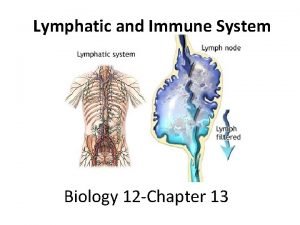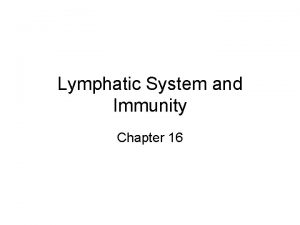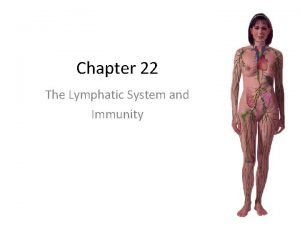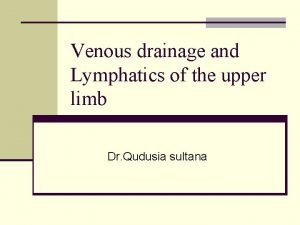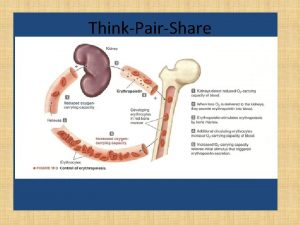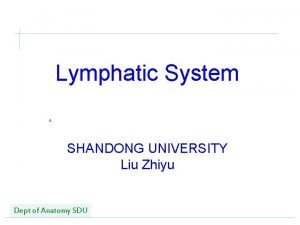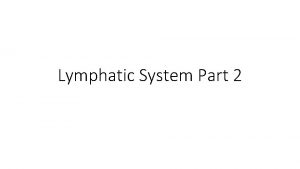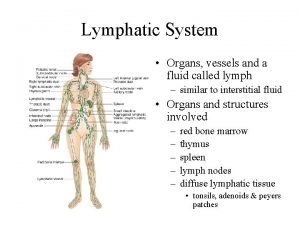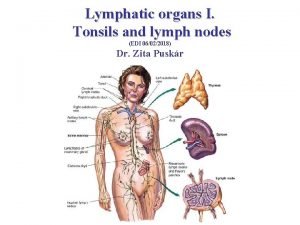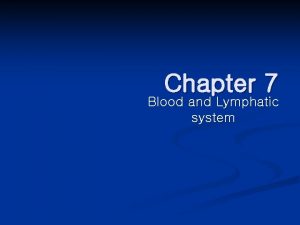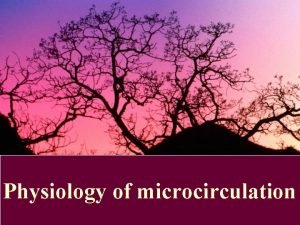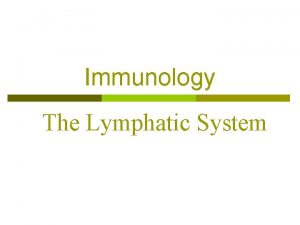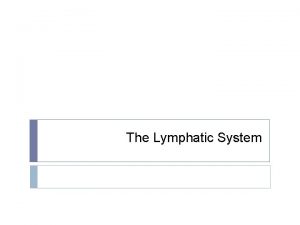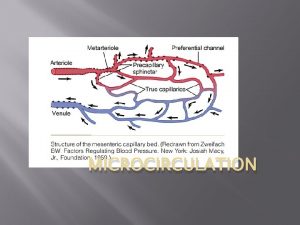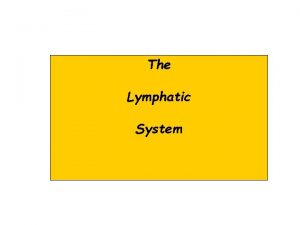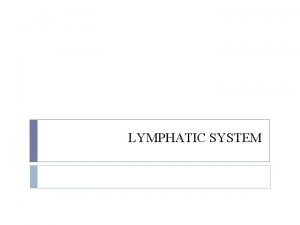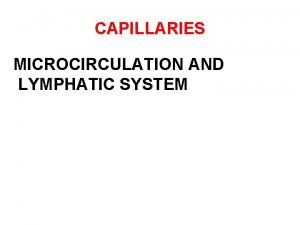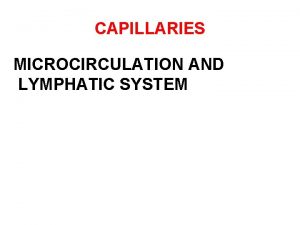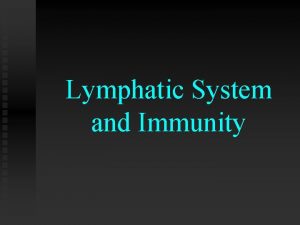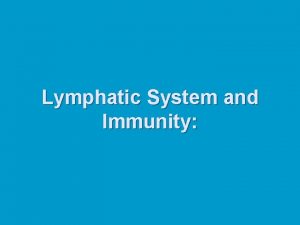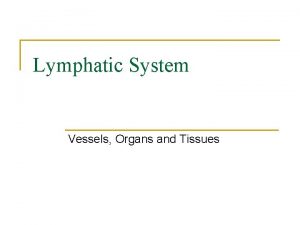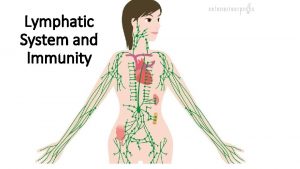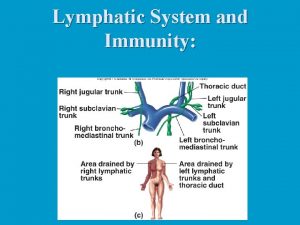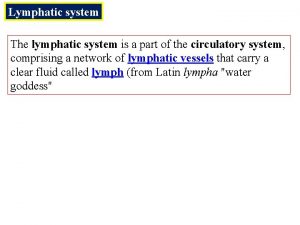Microcirculation and lymphatic system Microcirculation Most purposeful function
































- Slides: 32

Microcirculation and lymphatic system

Microcirculation • Most purposeful function of circulation – Nutrient transport – Cell excreta removal • Regulation of blood flow – Small arterioles – Local conditions within the tissue • Diameter of arterioles

• Structural organization – Organ-specific • Meet its demands – Nutrient artery • Braches 6 to 8 times – Arterioles

• Structural organization – Arterioles • Highly muscular – Changes in diameter – Metarterioles (terminal arterioles) • Smooth muscles – No muscle sheath

• Structural organization – True capillary • Smooth muscle fibers – Precapillary sphincter – Venules • Larger than capillary • Weak musculature

• Metarterioles and precapillary shincter – Close contact with tissue • Regulation of blood flow – Local condition of tissues

Capillaries • Capillary wall – Extremely thin • Highly permeable – Single endothelial cell layer – Basement membrane • Diameter – 4 to 9 micrometer • Barely large enough passage for RBC and other cells

• Movement of solute and water – Intercellular cleft • Thin slit, curving channels • Large amount of transport activity – Plasmalemmal vesicles • Endocytosis • Picnocytosis – Vesicular channels • Little of important

• Specialization – Brain • Blood-brain barrier (tight junctions) – Only small molecules can pass – Liver • Larger pores and slits – GI capillary membrane • Intermediate in size – Glomerular tufts of kidney • Fenestrae (oval window) – Large amount of small molecules and ions

Vasomotion • Capillary flow – Intermittent rather than continuous – Vasomotion • Intermittent contraction of metarterioles and precapillary sphincter • Regulated by oxygen concentrations – Decrease in oxygen concentration (greater tissue demand), increase in vasomotion (increased frequency with longer duration)

Exchange of solutes and water • Diffusion – Most important method of transfer – Results from thermal motion of the water molecules and solutes in the fluid

• Movement of lipid-soluble substances – Direct diffusion • No pores required – Oxygen – Carbon dioxide – Faster than lipid-insoluble materials • Require facilitation

• Water-soluble materials – Intercellular cleft – Extremely efficient • Cleft occupy 1/1000 of the entire capillary surface area • Diffusion of water is 80 X faster than flow of plasma itself

Substance Molecular Weight Water Na. Cl Urea Glucose Sucrose Insulin Myoglobin Hemoglobin Albumin 18 58. 5 60 180 342 5000 17, 600 69, 000 • Molecular size – Different permeability • Tissue capillary-dependent Permeability 1. 00 0. 96 0. 8 0. 6 0. 4 0. 2 0. 03 0. 01. 0001

• Concentration gradient – Greater the difference in concentrations between inside and outside, faster the rate of diffusion – Rates of diffusion of most nutrients • Much greater than other materials • Require small concentration differences

Interstitium and interstitial fluid • Space between the cells – Structures • Collagen fiber bundles – Tensional strength • Proteoglycan filaments – Thin, coiled/twisted molecule (98 % hyaluronic acid, 2 % protein) – Forms brush pile (reticular filaments)

• Interstitial fluid – Filtrate and diffusion of plasma components • Same constituents but lower concentrations of proteins – Entrapped in minute space along proteoglycan filaments • Formation of tissue gel • Diffusion of fluid and molecules – Very rapid

• Interstitial fluid – Free fluid • Very small amount (less than 1 %) – Edema • Expansion of fluid stored in the interstitium until 50 % of fluid becomes free of proteoglycan – Rivulets – Pockets

Fluid filtration across capillary • Pressures – Hydrostatic • Physical pressure that forces fluid and solutes out of capillary via pores – Osmotic • Concentration gradient of plasma proteins – Movement of fluid out of interstitial space – Regulates amount of fluid being moved out of blood

• Role of lymphatic system – Return of excess fluid and proteins to blood • Leakage into interstitial space

Hydrostatic and colloid osmotic forces • Determination of fluid movement through capillary – Four forces • Capillary pressure (outward movement of fluid) • Interstitial fluid pressure (inward movement of fluid) • Capillary colloid plasma osmotic pressure (inward movement of fluid) • Interstitial fluid colloid osmotic pressure (outward movement of fluid)

• Net filtration pressure – Sum of these forces • Fluid filtration to the interstitium if positive • Fluid absorption to the blood if negative NFP = Pc-Pif- p+ if

• Other factors – Filtration coefficient (Kf) • Pore size • Pore number • Number of capillaries Filtration = Kf X NFP

Lymphatic system • Accessory route – Flow of fluid from interstitium to the blood • Movement of proteins and large particles away from tissue to the blood – Extremely critical • Lethal if no movement • Drainage – Channels • Not present on skin, the CNS, endomysium, and bones – Prelymphatics

• Thoracic duct – Common drainage of lymphatic ducts in the lower body and left side of head, left arm, and chest – Drains into left internal jugular and subclavian vein

• Right side of the body – Right lymph duct • Empty into right internal jugular and subclavian vein • 10 % of arterial blood – Enters lymphatic capillaries – Returns through lymphatic system • Removal of proteins

• Structural design of lymphatic capillary – Anchoring filaments • Formation of valve


Lymph formation • Derived from interstitial fluid – Same composition – Differences in protein concentrations • Average 2 g/dl (most tissues) • As high as 6 g/dl in lymphs from the liver • 3 -4 g/dl in lymphs from the intestine – Used for nutrient absorption • Lipids – Infectious agents • Destroyed

Rate of lymph flow • 100 ml per hour through thoracic duct • 20 ml per hour through other channels – 120 ml per hour – 2 -3 L per day • Increased interstitial fluid pressure, increased lymph flow – Changes in balance of fluid exchange

• Lymphatic pumps – Contraction of smooth muscles surrounding lymphatic and large lymph ducts – Compression of lymphatics • Rate of lymph flow – Interstitial fluid pressure X activity of lymphatic pumps

Regulation of interstitial fluid • Protein level – Accumulation of plasma proteins in the interstitium • Small but continuous leakage from the capillary – Alters colloid osmotic pressure – Alters fluid filtration rate and cause fluid accumulation – Alters interstitial fluid pressure and volume – Increased flow of lymph • Removal of proteins
 Microcirculation of spleen
Microcirculation of spleen What are the function of lymphatic system
What are the function of lymphatic system Largest lymphoid organ
Largest lymphoid organ Function of lymphatic system
Function of lymphatic system Lymphatic system lecture
Lymphatic system lecture Lymphatic system
Lymphatic system Lymphatic system vs endocrine system
Lymphatic system vs endocrine system Chapter 12 the lymphatic system and body defenses
Chapter 12 the lymphatic system and body defenses Hemic and lymphatic system
Hemic and lymphatic system Chapter 13 lymphatic system and immunity
Chapter 13 lymphatic system and immunity Chapter 12 the lymphatic system and body defenses
Chapter 12 the lymphatic system and body defenses Chapter 12 the lymphatic system and body defenses
Chapter 12 the lymphatic system and body defenses Chapter 16 lymphatic system and immunity
Chapter 16 lymphatic system and immunity Main components of lymphatic system
Main components of lymphatic system Chapter 10 lymphatic system diseases and disorders
Chapter 10 lymphatic system diseases and disorders Discriminative listening
Discriminative listening The best business writing is purposeful economical and
The best business writing is purposeful economical and A clarifying listener
A clarifying listener Direct and purposeful experiences
Direct and purposeful experiences Lymphatic system in lower legs
Lymphatic system in lower legs Functions of the lymphatic system
Functions of the lymphatic system Its tubular dude
Its tubular dude Median cubital vein
Median cubital vein Organization of the lymphatic system
Organization of the lymphatic system Abdominal wall lymphatic drainage
Abdominal wall lymphatic drainage Organization of the lymphatic system
Organization of the lymphatic system Lymphatic system organs
Lymphatic system organs Chapter 7:9 lymphatic system
Chapter 7:9 lymphatic system Tonsils histology
Tonsils histology Exercise 38
Exercise 38 Chapter 7:9 lymphatic system
Chapter 7:9 lymphatic system Lumbar trunk
Lumbar trunk Short tube that receives purified lymph
Short tube that receives purified lymph

